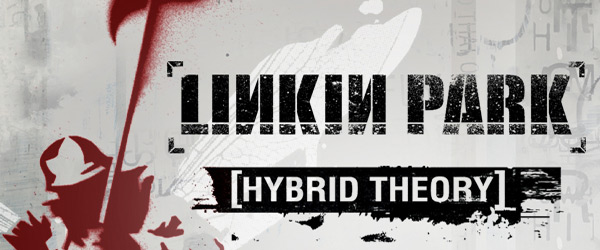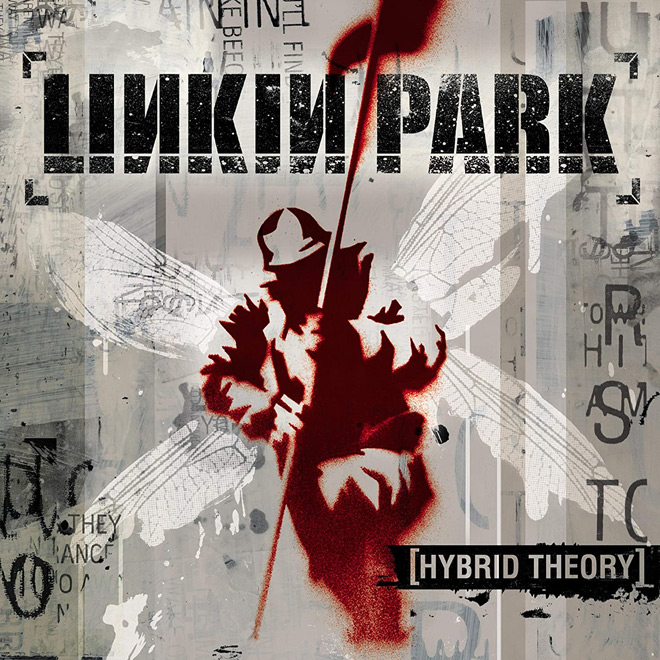October 2000. Madonna, Christina Aguilera, and Creed were sitting pretty atop the Billboard Charts. In the Rock-n-Roll world, a second wave of Nu Metal was rising to commercial prominence thanks to the likes of Papa Roach, Staind, and P.O.D. Little did anyone know that an unknown band out of California, a sextet called Linkin Park, were about to blow the scene wide open with their debut LP, Hybrid Theory, which arrived on Tuesday, October 24, 2000.
Formed in 1996 in Agoura Hills, it was not until 1999 that Linkin Park—then using the name Xero—solidified their line-up with the addition of a young vocalist from Arizona. Rechristening themselves Hybrid Theory, and ultimately Linkin Park, the new group—Vocalist Chester Bennington, Vocalist/Guitarist Mike Shinoda, Guitarist Brad Delson, Bassist Dave Farrell, DJ/Turntablist Joe Hahn, and Drummer Rob Bourdon—was an anomaly. At the time, a heavy band that incorporated Hip Hop, sported two lead singers, and utilized electronics was an enigma, operating in a world of their own making.
To rewind for a moment, as Hybrid Theory they delivered a self-titled 1999 EP, before getting signed and adopting the moniker Linkin Park. With the wheels set in motion, it would be the band’s masterful debut, Hybrid Theory, that would shake the music world and propel the young group to stardom. Delivering singles/videos for the likes of “One Step Closer,” “In the End,” “Crawling,” and “Papercut,” Linkin Park took over MTV, the Mainstream Rock charts, radio, and even crossed over onto the Pop charts. It was an astounding success for any band, let alone, a group who had been together for a year.
Being signed to a major label did not hurt their cause, though early on there was interference that could have spelled their demise before they were ever really known. Reportedly, Warner Brothers’ A&R was not thrilled with the band’s amalgamated sound and urged Bennington to stop sharing the vocal spotlight with Shinoda, whom they apparently saw as a kind of ‘weakest link.’ Of course, Bennington, loyal as he was, wouldn’t hear of it. Linkin Park refused to compromise their vision for their debut LP, and Hybrid Theory as we know it was born.
Produced by Don Gilmore (Good Charlotte, Lacuna Coil), Hybrid Theory was a deeply moving journey through Bennington’s emotionally vulnerable soul. Lyrical themes revolved around real life issues that the vocalist had faced in his formative years, from drug use to family problems, failed relationships, and his parents’ eventual divorce. Coupled with the sextet’s unique sonic approach and the dueling Rap Rock vocals of Shinoda and Bennington, it was an enormous debut packed full of much to digest.
Though the LP began with “Papercut,” it was the first single/video for “One Step Closer” that first introduced many of us to Linkin Park. In this, the very first words the world heard from Bennington made a powerful punch—“I cannot take this anymore.” As a unit, Linkin Park was pure fire, making anger and frustration so easily digestible with their infectious version of Rock-n-Roll. From the eerie visuals of its accompanying video to the musical approach that they would come to define as their own, “One Step Closer” was an immensely shocking and creatively inspired look at a band who would eventually rule the world.
But it hardly stopped there. On the LP’s actual first track, the aforementioned “Papercut,” the interplay between Shinoda and Bennington’s vocals was hypnotic, dragging each of us underneath the skin to feel what they were feeling—the angst, pain and paranoia. Eventually it too would be released as a single/video, the fourth from Hybrid Theory. Topically, it was really no different from the LP’s other 11 authentically raw tracks, songs like the rocking “With You” and intensely layered “Points of Authority.” The latter, of course, spurned 2002’s Reanimation remix LP, one of the best-selling remix albums of all time.
Third single/video, “Crawling,” was a more languid offering, a haunting look at the fear, insecurity, and overwhelming distractions that swirl within each of us. Born of the lack of control experienced by Bennington amid his drug and alcohol use, but easily related to many mental health issues, “Crawling” spoke to a legion of fans who felt trapped inside the cages of their own minds. It was yet another commercial success for the band, and it fit beautifully beside the likes of the personal “Runaway” and the agony of “By Myself.”
Linkin Park’s biggest single/video, however, would be the crossover success, “In the End,” which hit No. 1 on the Modern Rock charts and made showings on charts across the globe. Anchored by a piano riff from Shinoda, the emotional look at personal failure, or the demise of a relationship, if you prefer, was actually not a favorite of Bennington’s, who famously stated that he didn’t even want the song on the record. Thankfully, he was vetoed on this matter and, with its release, Linkin Park edged from the Rock and Metal world and began their ascent to household name.
But the genius of Hybrid Theory was that it constantly shifted sound profiles. So while a legion of new fans may have fallen in love with “In the End,” it was followed by the Hip Hop heavy “A Place For My Head,” the crumpled memories of “Forgotten,” and the epic instrumental “Cure for the Itch,” which allowed Mr. Hahn to shine. Ultimately, they ended their debut with the heartbreaking “Pushing Me Away,” Bennington’s soaring melodies lingering long after the collection had come to its stunning conclusion.
Since it’s initial release in October 2000, Hybrid Theory has been re-released in a multitude of formats, with an array of additional tracks, throughout the years. Most recently, Linkin Park celebrated its 20th anniversary with a 6CD/3DVD physical re-release that includes the original record, Reanimation, demos, and endless bonus content. Interestingly enough, one of this writer’s personal favorite bonus tracks, “My December,” originally heard on the Japanese version of Hybrid Theory, was covered by Operatic Pop sensation Josh Groban on his 2003 LP Closer, as well as its accompanying headlining tour. Talk about crossing genre boundaries!
Hybrid Theory placed Linkin Park onto all the charts—it peaked at No. 2 on the Billboard 200, has been certified 12-times Platinum, took home a Grammy for “Crawling,” and is the best-selling debut album since Guns N’ Roses’ legendary 1987 release, Appetite for Destruction. Not to mention, it is the best-selling Rock LP of the 21st century. And all of this laid the groundwork for what was soon to come from Linkin Park: their own Projekt Revolution tour, 2003’s Meteora, 2004’s Collision Course EP with Jay-Z that landed them a second Grammy, and so very much more. In this, it was much more than a debut album: it truly was a revolution of sound!
Just as sincerely bewitching and hauntingly vulnerable a collection as it was when it first hit shelves 20 years ago, Hybrid Theory stands as a testament to a band who has consistently shoved boundaries aside, remained loyal to one another and their fans, and, despite the tragic loss of the exceptional Bennington in 2017, has recently stated that they will continue on in creating new music. Influential, philanthropic, a thoughtful and honest band that has become a prominent fixture on the world stage, as Linkin Park celebrates two decades since their debut, we wish them many decades more.

Linkin Park Celebrates 20 Years of Hybrid Theory
Category(s)Album RetrospectivesCryptic RockCrypticRockNews
Tags2000 album2000 music20th anniversaryA Place For My HeadAlbum AnniversaryAlcoholAlt RockAngstbest-selling Rock LPBillboardboundary defyingBrad DelsonBy MyselfCalifornia bandChester BenningtonCollision Course EPcommercial successCrawlingcross-genreCure for the ItchDave Farrelldebut albumDon Gilmoredrug useemotionally vulnerablefailed relationshipsForgottengenre-defyingglobal successGrammy Awardhip hopHybrid TheoryI cannot take this anymoreIn The EndJoe HahnJosh GrobanLinkin Parkmental healthMeteoraMike ShinodaModern Rockmusic anniversaryMy Decembernu metalOctober 24 2000One Step CloserPapercutParanoiaphenomenal debutPoints of AuthorityProjekt Revolution tourPushing Me Awayrap rockreanimationRob BourdonrockRunawaytwo lead singersWith YouXero





No comment